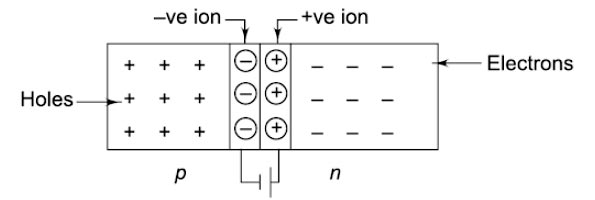Which of the following in semiconductors cannot move?
Right Answer is:
Ions
SOLUTION
Consider the p-n junction at room temperature (say 300°K). The region to the left side of the junction is p-type. It has a large number of holes as the majority carriers and the region to the right is n-type. It has a large number of electrons as charge carriers.
After a few carriers diffuse into the other region, there is the development of equal and opposite charges (immobile) on the two sides of the junction. Because as an electron from n region diffuses into the p region it leaves behind a positive ion and the hole when moves to the n region from the p region, leaves behind a negative ion. A layer of positive and negative ions across the junction forms a depletion layer.

During diffusion, the electrons move from it to the p-side, and hence conventional current is from P to N. Similarly, because of the diffusion of holes from P to N side the current is in the same direction. Thus the diffusion currents due to majority carriers in the two regions add up and give a net forward current IF from p.
The region across the P-N junction in which the potential changes from positive to negative is called the depletion region. Since this region has immobile (fixed) ions that are electrically charged, it is all called the space-charge region. Outside this region on each side of the junction, the material is still neutral.
